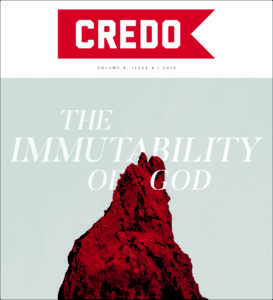Have Christians always held the same beliefs about God? Why did they think it was okay to use language not found in Scripture to describe God? Were they trying to go beyond what God has revealed of himself and speculate about what he might be like? I remember asking these questions because they were first posed to me by Mormons. I wanted to have an answer for them and so I studied Scripture, what other Christians had said about God, and thought deeply about the words and concepts I would use to communicate what I had learned. What I soon realized is that many Christians from the early and medieval church eras had done something very similar: they studied Scripture, listened to those who came before them, and thought hard about how to teach who God is to fellow Christians and how respond to other questions or attacks. Thus, I began to study what some call the “classical” view of God and quickly discovered the deep value of reading these texts. Here I will briefly describe five major figures and their contribution to the classical view of God.
Five Major Figures
Irenaeus of Lyons (ca. 130–200) was a bishop who learned from Polycarp, a disciple of the apostle John. In Against Heresies he emphasizes the unity and transcendence of God. Using a metaphor, he explains God’s relationship to the world through his “two hands,” the Son and the Spirit. God created the world out of nothing, owing his existence to nothing while also affirming the goodness of his creation. Irenaeus formed these theological concepts as he engaged the heretics of his time – mostly Gnosticism and Montanism – and while reading Scripture, the apostolic fathers, and others. In response to false teaching, Irenaeus sought to communicate the truth of Scripture in language and concepts that were faithful to it (e.g., the “rule of faith”), but that also made sense to his contemporaries.
Gregory of Nyssa (ca. 335–395)
Gregory was an Eastern bishop and one of the three Cappadocians (Basil of Caesarea, his older brother, and Gregory of Nazianzus). He knew Scripture well and used it to respond to some of the critics of a classical view of God, especially Eunomius. In Against Eunomius he argues that God is infinite, beyond definition, simple (or indivisible), and trinitarian. What we can name are God’s attributes which have been revealed in Scripture. However, Eunomius believed that God’s only real attribute is that he is “unbegotten,” or not created, which cannot be said of the Son (since he is begotten) or Holy Spirit. Gregory believed this to be a poor reading of Scripture since it uses many names, titles, and descriptions of God without dividing him in any way. In this sense, God is simple – he cannot be divided into parts.
In That There Are Not Three Gods Gregory also argued that we see God’s simple unity in the inseparable operations (or actions) of the three trinitarian persons. The Father, Son, and Holy Spirit do not merely work together toward a unified goal; rather, they act as one so that when they give life it is not three different givings of life, but the one God giving life. Gregory, and others, understood God’s action to be distinct but undivided, just as God has distinctions but is also undivided. Gregory did not come up with these conclusions on his own, but drew them from Scripture in the context of his desire to form a response to Eunomius’ false teachings and other attacks.
Augustine (354–430)
Augustine was born in North Africa and was bishop of Hippo. He is arguably the most important and influential theologian in the West. While he is often known for Confessions or The City of God, Augustine’s On the Trinity (written 399–419) provides important insights into a classical understanding of God according to Scripture. His aim was to help other Christians understand how the church made sense of the various biblical texts, especially in response to heresies such as Arianism (which came in many forms).
One passage from the New Testament plays an important role in Augustine’s argument: “Christ the power of God and the wisdom of God” (1 Cor. 1:24). Some Arians taught that this passage meant that Jesus is the Father’s power and wisdom and that the Father is not actually powerful and wise on his own. Similar to Gregory, Augustine argued that Scripture uses multiple titles, names, and descriptions of God and that they all (except for the personal names) refer equally to the three persons. Augustine’s attempt was to remain faithful to Scripture, believing it taught that the Trinity is unchanging, simple, and unified. As a simple being, God does not have wisdom, but is wisdom and is love and all of the other divine attributes. Click To Tweet
Anselm (1033–1109)
Anselm was born northern Italy and is the first major figure of the medieval Western church. His Monologion and Proslogion offered a “proof” for the existence of God as an attempt to understand what he already believed. As a contemplation of God who is revealed as Father, Son, and Holy Spirit, Anselm argued that God cannot be fully understood as he is, is one, and cannot be divided into parts. As a simple being, God does not have wisdom, but is wisdom and is love and all of the other divine attributes. He cites Scripture throughout the Proslogion and is also indebted to Augustine’s view of God.
Thomas Aquinas (1225–74)
Thomas was born in southern Italy and is most famous for his Summa Theologiae and its influence on the West, particularly in Roman Catholicism. He wrote commentaries on Scripture and made frequent use of Aristotle and his philosophical categories throughout his writings. Thomas’ goal was not to revise a classical view of God, but to translate it to his contemporaries who knew Scripture but also thought along the lines of Aristotle’s categories. The goal of Thomas’ Summa was to serve the education of other Dominican friars by preparing them for the task of preaching and the hearing of confessions. He continues in the line of Augustine and others, arguing that God is simple, good, perfect, infinite, and present everywhere. He is also unchanging, eternal, love, and triune.
A strong line of continuity
As I studied the classical view of God I soon realized that theologians used a variety of terms, concepts, and categories to describe God. I worried that as they borrowed from the philosophies surrounding them that they were compromising the truth of the Christian faith as it is found in Scripture. However, I eventually found that these diverse voices were singularly trying to read Scripture well and communicate its content in different contexts and in the face of various false teachings. I discovered a strong line of continuity and development guided by Scripture and unified by the conclusions that God is triune, infinite, unchanging, simple, and that his actions are inseparable.


